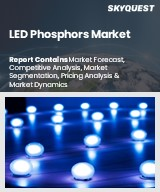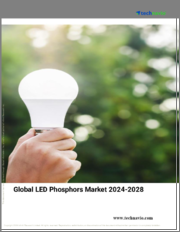
|
시장보고서
상품코드
1777326
LED 형광체 시장 규모, 점유율, 성장 분석 : 유형별, 용도별, 지역별 - 산업 예측(2025-2032년)LED Phosphors Market Size, Share, and Growth Analysis, By Type (Phosphate, Garnet), By Application (Automotive, Portable PCs), By Region - Industry Forecast 2025-2032 |
||||||
세계의 LED 형광체 시장 규모는 2023년에 18억 달러로 평가되며, 2024년 19억 5,000만 달러에서 2032년에는 37억 8,000만 달러로 성장하며, 예측 기간(2025-2032년)의 CAGR은 8.6%로 성장할 전망입니다.
세계 LED 형광체 시장은 에너지 효율이 높은 조명 솔루션에 대한 수요 증가와 청색광과 자외선을 고품질 백색광으로 효과적으로 변환하는 형광체 소재의 발전으로 인해 크게 성장하고 있습니다. 이러한 추세는 스마트 조명, 자동차 헤드라이트, TV 및 스마트폰의 디스플레이 백라이트에 적용되면서 증폭되고 있습니다. 양자점 형광체와 같은 혁신적인 기술은 효율성과 지속가능성을 모두 향상시킵니다. 아시아태평양, 특히 중국은 탄탄한 제조와 유리한 정책으로 생산에서 선두를 달리고 있습니다. 그러나 희토류 관련 환경 문제, 공급망 취약성 등의 과제도 남아있습니다. 최근 사건으로 인해 데이터 보안 개선의 필요성이 부각되는 한편, LED 형광체 채택을 둘러싼 윤리적 고려사항이 시장 역학에 계속 영향을 미치고 있습니다.
목차
서론
- 조사의 목적
- 조사 범위
- 정의
조사 방법
- 정보 조달
- 2차와 1차 데이터 방법
- 시장 규모 예측
- 시장의 전제조건과 제한
개요
- 세계 시장 전망
- 공급과 수요 동향 분석
- 부문별 기회 분석
시장 역학과 전망
- 시장 개요
- 시장 규모
- 시장 역학
- 촉진요인과 기회
- 억제요인과 과제
- Porter의 산업 분석
주요 시장 인사이트
- 주요 성공 요인
- 경쟁의 정도
- 주요 투자 기회
- 시장 에코시스템
- 시장의 매력 지수(2024년)
- PESTEL 분석
- 거시경제 지표
- 밸류체인 분석
- 가격 분석
- 사례 연구
- 고객 구매 행동 분석
LED 형광체 시장 규모 : 유형별 & CAGR(2025-2032)
- 시장 개요
- 인산
- 가넷
- 규산염
- 질화물
- 기타
LED 형광체 시장 규모 : 용도별 & CAGR(2025-2032)
- 시장 개요
- 자동차
- 휴대용 PC
- 스마트폰
- 박형 TV
- 사이니지
- 점등
- 기타
LED 형광체 시장 규모 : 지역별 & CAGR(2025-2032)
- 북미
- 미국
- 캐나다
- 유럽
- 독일
- 스페인
- 프랑스
- 영국
- 이탈리아
- 기타 유럽 지역
- 아시아태평양
- 중국
- 인도
- 일본
- 한국
- 기타 아시아태평양
- 라틴아메리카
- 브라질
- 기타 라틴아메리카 지역
- 중동 및 아프리카
- GCC 국가
- 남아프리카공화국
- 기타 중동 및 아프리카
경쟁 정보
- 상위 5사의 비교
- 주요 기업의 시장 포지셔닝(2024년)
- 주요 시장 기업이 채택한 전략
- 최근 시장 동향
- 기업의 시장 점유율 분석(2024년)
- 주요 기업의 기업 개요
- 기업의 상세
- 제품 포트폴리오 분석
- 기업의 부문별 점유율 분석
- 매출의 전년대비 비교(2022-2024년)
주요 기업 개요
- Stanley Electric Co. Ltd.
- Avago Technologies
- Osram Sylvania Inc.(OSRAM GmbH)
- General Electric Company
- Edison Opto Corporation
- Kingbright Electronic Co.
- Universal Display Corporation
- Nichia Corporation
- Epistar Corporation
- Philips Lumileds Lighting Company
- Seoul Semiconductor Co. Ltd.
- Citizen Electronics Co. Ltd.
- Cree Inc.
결론과 제안
KSA 25.08.01Global LED Phosphors Market size was valued at USD 1.8 billion in 2023 and is poised to grow from USD 1.95 billion in 2024 to USD 3.78 billion by 2032, growing at a CAGR of 8.6% during the forecast period (2025-2032).
The global LED phosphors market is witnessing significant growth driven by the escalating demand for energy-efficient lighting solutions and advancements in phosphor materials that effectively convert blue or UV light into high-quality white light. This trend is amplified by applications in smart lighting, automotive headlights, and display backlighting for televisions and smartphones. Innovative technologies such as quantum dot phosphors enhance both efficiency and sustainability. The Asia-Pacific region, particularly China, leads in production due to robust manufacturing and favorable policies. However, challenges persist, including environmental concerns related to rare earth elements and supply chain vulnerabilities. Recent incidents have highlighted the need for improved data security, while ethical considerations surrounding the adoption of LED phosphors continue to impact market dynamics.
Top-down and bottom-up approaches were used to estimate and validate the size of the Global LED Phosphors market and to estimate the size of various other dependent submarkets. The research methodology used to estimate the market size includes the following details: The key players in the market were identified through secondary research, and their market shares in the respective regions were determined through primary and secondary research. This entire procedure includes the study of the annual and financial reports of the top market players and extensive interviews for key insights from industry leaders such as CEOs, VPs, directors, and marketing executives. All percentage shares split, and breakdowns were determined using secondary sources and verified through Primary sources. All possible parameters that affect the markets covered in this research study have been accounted for, viewed in extensive detail, verified through primary research, and analyzed to get the final quantitative and qualitative data.
Global LED Phosphors Market Segments Analysis
Global LED Phosphors Market is segmented by Type, Application and region. Based on Type, the market is segmented into Phosphate, Garnet, Silicate, Nitride and Others. Based on Application, the market is segmented into Automotive, Portable PCs, Smartphones, Flat Panel TVs, Signage, Lighting and Others. Based on region, the market is segmented into North America, Europe, Asia Pacific, Latin America and Middle East & Africa.
Driver of the Global LED Phosphors Market
The global demand for LED phosphors is significantly driven by the escalating emphasis on energy conservation and sustainability, along with regulatory frameworks aimed at promoting green lighting solutions. The implementation of policies like the EU Ecodesign Directive and China's Green Lighting Policy further fuels this trend. Phosphors play a crucial role in enhancing the efficiency and luminous output of LEDs, making their application vital across various sectors, including smart lighting, automotive, and consumer electronics. This increasing reliance on LED technology is poised to accelerate market growth, with projections indicating that LEDs could eventually dominate a substantial portion of global lighting applications.
Restraints in the Global LED Phosphors Market
The Global LED Phosphors market faces significant constraints due to the heavy reliance on rare earth elements like yttrium and europium, with over 80% of these materials being sourced from China. This concentration raises concerns regarding supply chain stability and price fluctuations. Additionally, geopolitical tensions and potential export restrictions can disrupt access to these critical materials, leading to increased production costs for companies within the industry. Consequently, these challenges may impede the growth and profitability of businesses operating in the LED phosphors sector, as they adapt to an uncertain and rapidly changing market environment.
Market Trends of the Global LED Phosphors Market
The Global LED Phosphors market is experiencing a significant shift towards the utilization of quantum dot phosphors, driven by their superior performance in color rendering, brightness, and energy efficiency. With light emission accuracy achieving color rendering indices (CRI) above 90 and a remarkable 20% improvement in luminous efficacy, quantum dot phosphors are becoming the preferred choice for high-end applications such as 4K/8K TV panels, smart lighting solutions, and automotive headlights. Major brands, such as LG with their NanoCell TVs, are leveraging this technology to produce vibrant colors while enhancing energy conservation, appealing to environmentally conscious consumers. This trend indicates a growing demand for innovative and efficient LED solutions in the market.
Table of Contents
Introduction
- Objectives of the Study
- Scope of the Report
- Definitions
Research Methodology
- Information Procurement
- Secondary & Primary Data Methods
- Market Size Estimation
- Market Assumptions & Limitations
Executive Summary
- Global Market Outlook
- Supply & Demand Trend Analysis
- Segmental Opportunity Analysis
Market Dynamics & Outlook
- Market Overview
- Market Size
- Market Dynamics
- Drivers & Opportunities
- Restraints & Challenges
- Porters Analysis
- Competitive rivalry
- Threat of substitute
- Bargaining power of buyers
- Threat of new entrants
- Bargaining power of suppliers
Key Market Insights
- Key Success Factors
- Degree of Competition
- Top Investment Pockets
- Market Ecosystem
- Market Attractiveness Index, 2024
- PESTEL Analysis
- Macro-Economic Indicators
- Value Chain Analysis
- Pricing Analysis
- Case Studies
- Customer Buying Behavior Analysis
Global LED Phosphors Market Size by Type & CAGR (2025-2032)
- Market Overview
- Phosphate
- Garnet
- Silicate
- Nitride
- Others
Global LED Phosphors Market Size by Application & CAGR (2025-2032)
- Market Overview
- Automotive
- Portable PCs
- Smartphones
- Flat Panel TVs
- Signage
- Lighting
- Others
Global LED Phosphors Market Size & CAGR (2025-2032)
- North America (Type, Application)
- US
- Canada
- Europe (Type, Application)
- Germany
- Spain
- France
- UK
- Italy
- Rest of Europe
- Asia Pacific (Type, Application)
- China
- India
- Japan
- South Korea
- Rest of Asia-Pacific
- Latin America (Type, Application)
- Brazil
- Rest of Latin America
- Middle East & Africa (Type, Application)
- GCC Countries
- South Africa
- Rest of Middle East & Africa
Competitive Intelligence
- Top 5 Player Comparison
- Market Positioning of Key Players, 2024
- Strategies Adopted by Key Market Players
- Recent Developments in the Market
- Company Market Share Analysis, 2024
- Company Profiles of All Key Players
- Company Details
- Product Portfolio Analysis
- Company's Segmental Share Analysis
- Revenue Y-O-Y Comparison (2022-2024)
Key Company Profiles
- Stanley Electric Co. Ltd.
- Company Overview
- Business Segment Overview
- Financial Updates
- Key Developments
- Avago Technologies
- Company Overview
- Business Segment Overview
- Financial Updates
- Key Developments
- Osram Sylvania Inc. (OSRAM GmbH)
- Company Overview
- Business Segment Overview
- Financial Updates
- Key Developments
- General Electric Company
- Company Overview
- Business Segment Overview
- Financial Updates
- Key Developments
- Edison Opto Corporation
- Company Overview
- Business Segment Overview
- Financial Updates
- Key Developments
- Kingbright Electronic Co.
- Company Overview
- Business Segment Overview
- Financial Updates
- Key Developments
- Universal Display Corporation
- Company Overview
- Business Segment Overview
- Financial Updates
- Key Developments
- Nichia Corporation
- Company Overview
- Business Segment Overview
- Financial Updates
- Key Developments
- Epistar Corporation
- Company Overview
- Business Segment Overview
- Financial Updates
- Key Developments
- Philips Lumileds Lighting Company
- Company Overview
- Business Segment Overview
- Financial Updates
- Key Developments
- Seoul Semiconductor Co. Ltd.
- Company Overview
- Business Segment Overview
- Financial Updates
- Key Developments
- Citizen Electronics Co. Ltd.
- Company Overview
- Business Segment Overview
- Financial Updates
- Key Developments
- Cree Inc.
- Company Overview
- Business Segment Overview
- Financial Updates
- Key Developments













